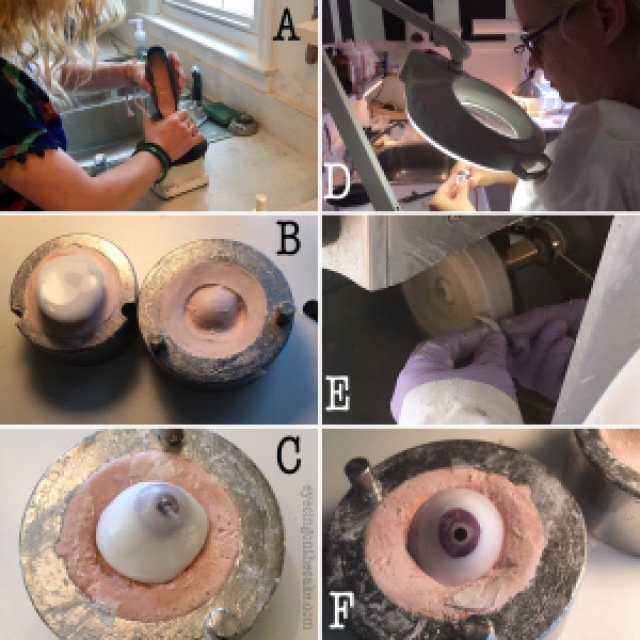Who makes prosthetic eyes?
An ocularist is someone who fits and makes artificial, or prosthetic, eyes.
Why would one need a prosthetic eye?
There are cases in which the eye cannot be saved. Some of those include eye cancer and trauma/injury. A blind eye that becomes painful may also need to be removed. Prosthetic eyes are also utilized in cases of congenital abnormalities like anophthalmia, when a child is born without one or both eyes, or microphthalmia, when a child is born with one or both eyes being abnormally small. Beyond that, there are situations where the eye remains, but it is blind and misaligned. In those cases, a scleral shell can be made to be worn over the natural eye to improve cosmesis.
When the eye needs to be removed, it can be done via enucleation or evisceration. An enucleation involves removing the entire eye, while an evisceration involves removing the contents of the eye but keeping the outer shell of the eye (the sclera) and leaving the optic nerve and ocular muscles intact (1).
An orbital implant is then placed in the eye socket to maintain the volume of the eye. There are different types of orbital implants, mainly solid acrylic implants and porous implants. Porous implants allow tissue growth within them, leading to better mobility and stability. After an enucleation or evisceration, a temporary plastic conformer is placed in the socket in front of the implant to hold the shape until the wounds heal and a prosthetic can be placed. The prosthesis fits over the orbital implant and under the eyelids.
 |
| Examples of porous orbital implants via Marie Allen Ocularist |
How is a prosthetic eye made?
I’m so glad you asked! I had the pleasure of spending a day at Carolina Eye Prosthetics to see how they make prosthetic eyes, and it was fascinating! I got to watch the process from start to finish, and here’s my overview of the process. *I watched a couple of eyes get made that day, so the images below are of two different prosthetic eyes.*
1. First, an impression is made. Vinyl polysiloxane impression material (the same stuff used to get dental impressions) is used to get an impression of the eye socket. The ocularist puts an impression tray into the eye, and uses a gun to push the impression “goo” into the eye socket. After a few minutes, the impression is removed from the eye socket.
2. A cast is made to create a wax version of the eye. A flat, black iris disk is also put in the mold, with a clear, round acrylic button over top, simulating the cornea. There is a peg sticking out of the button that helps the ocularist determine the eye’s gaze.
 |
| The impression is used to make a mold (A,B), and the mold is then filled with wax (C). The wax eye is made (D) and the iris button is added (E). |
The wax eye is put into the patient’s eye socket, and modifications are made as needed. The ocularist alters and sculpts the wax eye many times to get the ideal fit and positioning.
 |
| Painting the eye |
6. Finally, the eye is buffed and polished. TADA!
 |
| My souvenir from the day! |
How are the prosthetic eyes inserted and removed?
To insert the prosthetic eye, hold the upper lid and gently push the prosthesis under the upper lid. If needed, a tug at the bottom lid helps get the bottom portion of the prosthesis under the lid. Removal is done with a DMV suction cup, which basically acts as a tiny plunger.
Special thanks to the lovely and talented ladies at Carolina Eye Prosthetics for allowing me to shadow them all day!
CliffsNotes: Ocularists are wizards, and prosthetic eyes are amazing.
Additional Recommended Resources:





Fabulous blog…I have no words for such a amazing blog…Which is i never had seen earlier….Amazing this is very unique for me….I really like the way you share
This comment has been removed by the author.
In cases of eye injury, trauma or any serious eye conditions sometimes patient lost their eye in that condition prosthetic eye is implanted. It is not a natural eye which needs proper attention and care to be comfortable with Eye. A person can not see with that eye once the natural eye is removed and artificial implanted.